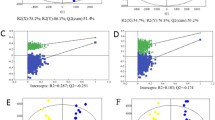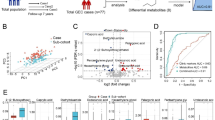Abstract
Introduction
Previous metabolomics studies have revealed perturbed metabolic signatures in esophageal squamous cell carcinoma (ESCC) patients, however, most of these studies included mainly late-staged ESCC patients due to the difficulties of collecting the early-staged samples from asymptotic ESCC subjects.
Objectives
This study aims to explore the early-staged ESCC metabolic signatures and potential of serum metabolomics to diagnose ESCC at early stages.
Methods
Serum samples of 97 ESCC patients (stage 0, 39 cases; stage I, 17 cases; stage II, 11 cases, stage III, 30 cases) and 105 healthy controls (HC) were enrolled and randomly separated into training data (77 ESCCs, 84 HCs) and validation data (20 ESCCs, 21 HCs). Untargeted metabolomics was performed to identify ESCC-related metabolic signatures.
Results
The global metabolomics profiles could clearly distinguish ESCC from HC in training data. 16 ascertained metabolites were found to be disturbed in the metabolic pathways characterized by dysregulated fatty acid biosynthesis, glycerophospholipid metabolism, choline metabolism in cancer and linoleic acid metabolism. The AUC value in validation data was 0.895, with sensitivity 85.0 % and specificity 90.5 %. Good diagnostic performances were also achieved for early stage ESCC, with the values of area under the curve (AUC) 0.881 for the ESCC patients in both stage 0 and I–II. In addition, six metabolites were found to discriminate ESCC stages. Among them, three biomarkers, dodecanoic acid, LysoPA(18:1), and LysoPC(14:0), exhibited clear trend for ESCC progression.
Conclusion
These findings suggest serum metabolomics, performed in a minimally noninvasive and convenient manner, may possess great potential for early diagnosis of ESCC patients.





Similar content being viewed by others
References
Aboagye, E. O., & Bhujwalla, Z. M. (1999). Malignant transformation alters membrane choline phospholipid metabolism of human mammary epithelial cells. Cancer Research, 59, 80–84.
Banni, S., Angioni, E., Casu, V., et al. (1999). Decrease in linoleic acid metabolites as a potential mechanism in cancer risk reduction by conjugated linoleic acid. Carcinogenesis, 20, 1019–1024.
Chow, C. K. (2009). Fatty acid composition of plasma phospholipids and risk of prostate cancer. Am J Clin Nutr, 89, 1946. author reply 1946–7.
Crowe, F. L., Allen, N. E., Appleby, P. N., et al. (2008). Fatty acid composition of plasma phospholipids and risk of prostate cancer in a case-control analysis nested within the European Prospective Investigation into Cancer and Nutrition. American Journal of Clinical Nutrition, 88, 1353–1363.
Davis, V. W., Schiller, D. E., Eurich, D., & Sawyer, M. B. (2012). Urinary metabolomic signature of esophageal cancer and Barrett’s esophagus. World J Surg Oncol, 10, 271.
Dawsey, S. M., Fleischer, D. E., Wang, G. Q., et al. (1998). Mucosal iodine staining improves endoscopic visualization of squamous dysplasia and squamous cell carcinoma of the esophagus in Linxian, China. Cancer, 83, 220–231.
Dawsey, S. M., Lewin, K. J., Wang, G. Q., et al. (1994). Squamous esophageal histology and subsequent risk of squamous cell carcinoma of the esophagus. A prospective follow-up study from Linxian, China. Cancer, 74, 1686–1692.
Djukovic, D., Baniasadi, H. R., Kc, R., Hammoud, Z., & Raftery, D. (2010). Targeted serum metabolite profiling of nucleosides in esophageal adenocarcinoma. Rapid Communications in Mass Spectrometry, 24, 3057–3062.
Dong, Z., Tang, P., Li, L., & Wang, G. (2002). The strategy for esophageal cancer control in high-risk areas of China. Japanese Journal of Clinical Oncology, 32(Suppl), S10–S12.
Dunn, W. B., Broadhurst, D., Begley, P., et al. (2011). Procedures for large-scale metabolic profiling of serum and plasma using gas chromatography and liquid chromatography coupled to mass spectrometry. Nature Protocols, 6, 1060–1083.
Eliyahu, G., Kreizman, T., & Degani, H. (2007). Phosphocholine as a biomarker of breast cancer: molecular and biochemical studies. International Journal of Cancer, 120, 1721–1730.
Fang, J. L., Vaca, C. E., Valsta, L. M., & Mutanen, M. (1996). Determination of DNA adducts of malonaldehyde in humans: effects of dietary fatty acid composition. Carcinogenesis, 17, 1035–1040.
Glunde, K., Bhujwalla, Z. M., & Ronen, S. M. (2011). Choline metabolism in malignant transformation. Nature Reviews Cancer, 11, 835–848.
Glunde, K., Jacobs, M. A., & Bhujwalla, Z. M. (2006). Choline metabolism in cancer: implications for diagnosis and therapy. Expert Review Molecular Diagnostics, 6, 821–829.
Guanrei, Y., & Songliang, Q. (1987). Endoscopic surveys in high-risk and low-risk populations for esophageal cancer in China with special reference to precursors of esophageal cancer. Endoscopy, 19, 91–95.
Hanahan, D., & Weinberg, R. A. (2011). Hallmarks of cancer: the next generation. Cell, 144, 646–674.
Hasim, A., Ma, H., Mamtimin, B., et al. (2012). Revealing the metabonomic variation of EC using (1)H-NMR spectroscopy and its association with the clinicopathological characteristics. Molecular Biology Reports, 39, 8955–8964.
Ikeda, A., Nishiumi, S., Shinohara, M., et al. (2012). Serum metabolomics as a novel diagnostic approach for gastrointestinal cancer. Biomedical Chromatography, 26, 548–558.
Iorio, E., Mezzanzanica, D., Alberti, P., et al. (2005). Alterations of choline phospholipid metabolism in ovarian tumor progression. Cancer Research, 65, 9369–9376.
Jin, H., Qiao, F., Chen, L., Lu, C., Xu, L., & Gao, X. (2014). Serum metabolomic signatures of lymph node metastasis of esophageal squamous cell carcinoma. Journal of Proteome Research, 13, 4091–4103.
Ke, C., Hou, Y., Zhang, H., et al. (2015). Large-scale profiling of metabolic dysregulation in ovarian cancer. International Journal of Cancer, 136, 516–526.
Kuhl, C., Tautenhahn, R., Bottcher, C., Larson, T. R., & Neumann, S. (2012). CAMERA: an integrated strategy for compound spectra extraction and annotation of liquid chromatography/mass spectrometry data sets. Analytical Chemistry, 84, 283–289.
Kumar, S., Huang, J., Cushnir, J. R., Spanel, P., Smith, D., & Hanna, G. B. (2012). Selected ion flow tube-MS analysis of headspace vapor from gastric content for the diagnosis of gastro-esophageal cancer. Analytical Chemistry, 84, 9550–9557.
Lin, Y., Totsuka, Y., He, Y., et al. (2013). Epidemiology of esophageal cancer in Japan and China. J Epidemiol, 23, 233–242.
Liu, R., Peng, Y., Li, X., et al. (2013). Identification of plasma metabolomic profiling for diagnosis of esophageal squamous-cell carcinoma using an UPLC/TOF/MS platform. International Journal of Molecular Sciences, 14, 8899–8911.
Lynam-Lennon, N., Connaughton, R., Carr, E., et al. (2014). Excess visceral adiposity induces alterations in mitochondrial function and energy metabolism in esophageal adenocarcinoma. BMC Cancer, 14, 907.
Ma, H., Hasim, A., Mamtimin, B., Kong, B., Zhang, H. P., & Sheyhidin, I. (2014). Plasma free amino acid profiling of esophageal cancer using high-performance liquid chromatography spectroscopy. World Journal of Gastroenterology, 20, 8653–8659.
Mir, S. A., Rajagopalan, P., Jain, A. P., et al. (2015). LC–MS-based serum metabolomic analysis reveals dysregulation of phosphatidylcholines in esophageal squamous cell carcinoma. Journal of Proteomics, 127, 96–102.
Morimoto, M., Nishiyama, K., Nakamura, S., et al. (2010). Significance of endoscopic screening and endoscopic resection for esophageal cancer in patients with hypopharyngeal cancer. Japanese Journal of Clinical Oncology, 40, 938–943.
Pearl, D. C. (2002). Proteomic patterns in serum and identification of ovarian cancer. Lancet, 360, 169–170. author reply 170–1.
Pennathur, A., Gibson, M. K., Jobe, B. A., & Luketich, J. D. (2013). Oesophageal carcinoma. Lancet, 381, 400–412.
Rice, T. W., Rusch, V. W., Ishwaran, H., & Blackstone, E. H. (2010). Cancer of the esophagus and esophagogastric junction: data-driven staging for the seventh edition of the American Joint Committee on Cancer/International Union Against Cancer Cancer Staging Manuals. Cancer, 116, 3763–3773.
Roshandel, G., Nourouzi, A., Pourshams, A., Semnani, S., Merat, S., & Khoshnia, M. (2013). Endoscopic screening for esophageal squamous cell carcinoma. Arch Iran Med, 16, 351–357.
Shen, Z., Wu, M., Elson, P., et al. (2001). Fatty acid composition of lysophosphatidic acid and lysophosphatidylinositol in plasma from patients with ovarian cancer and other gynecological diseases. Gynecologic Oncology, 83, 25–30.
Spratlin, J. L., Serkova, N. J., & Eckhardt, S. G. (2009). Clinical applications of metabolomics in oncology: a review. Clinical Cancer Research, 15, 431–440.
Steinberg, D., Parthasarathy, S., Carew, T. E., Khoo, J. C., & Witztum, J. L. (1989). Beyond cholesterol. Modifications of low-density lipoprotein that increase its atherogenicity. New England Journal of Medicine, 320, 915–924.
Vermeersch, K. A., & Styczynski, M. P. (2013). Applications of metabolomics in cancer research. Journal of Carcinogenesis, 12, 9.
Wang, L., Chen, J., Chen, L., et al. (2013). 1H-NMR based metabonomic profiling of human esophageal cancer tissue. Mol Cancer, 12, 25.
Wu, H., Xue, R., Lu, C., et al. (2009). Metabolomic study for diagnostic model of oesophageal cancer using gas chromatography/mass spectrometry. Journal of Chromatography B Analytical Technologies Biomedical Life Sciences, 877, 3111–3117.
Xu, J., Chen, Y., Zhang, R., et al. (2013). Global and targeted metabolomics of esophageal squamous cell carcinoma discovers potential diagnostic and therapeutic biomarkers. Molecular and Cellular Proteomics, 12, 1306–1318.
Yakoub, D., Keun, H. C., Goldin, R., & Hanna, G. B. (2010). Metabolic profiling detects field effects in nondysplastic tissue from esophageal cancer patients. Cancer Research, 70, 9129–9136.
Yang, Y., Wang, L., Wang, S., et al. (2013). Study of metabonomic profiles of human esophageal carcinoma by use of high-resolution magic-angle spinning 1H NMR spectroscopy and multivariate data analysis. Analytical and Bioanalytical Chemistry, 405, 3381–3389.
Yang, J., Wei, W. Q., Niu, J., Liu, Z. C., Yang, C. X., & Qiao, Y. L. (2012). Cost-benefit analysis of esophageal cancer endoscopic screening in high-risk areas of China. World Journal of Gastroenterology, 18, 2493–2501.
Zhang, J., Bowers, J., Liu, L., et al. (2012a). Esophageal cancer metabolite biomarkers detected by LC–MS and NMR methods. PLoS ONE, 7, e30181.
Zhang, H. Z., Jin, G. F., & Shen, H. B. (2012b). Epidemiologic differences in esophageal cancer between Asian and Western populations. Chinese Journal of Cancer, 31, 281–286.
Zhang, J., Liu, L., Wei, S., et al. (2011). Metabolomics study of esophageal adenocarcinoma. The Journal Thoracic and Cardiovascular Surgery, 141, 469–475. 475.e1–4.
Zhang, T., Wu, X., Ke, C., et al. (2013a). Identification of potential biomarkers for ovarian cancer by urinary metabolomic profiling. Journal of Proteome Research, 12, 505–512.
Zhang, X., Xu, L., Shen, J., et al. (2013b). Metabolic signatures of esophageal cancer: NMR-based metabolomics and UHPLC-based focused metabolomics of blood serum. Biochimica et Biophysica Acta, 1832, 1207–1216.
Zhao, L., Wei, W. Q., Zhao, D. L., et al. (2012). Population-based study of DNA image cytometry as screening method for esophageal cancer. World Journal of Gastroenterology, 18, 375–382.
Zock, P. L., & Katan, M. B. (1998). Linoleic acid intake and cancer risk: a review and meta-analysis. American Journal of Clinical Nutrition, 68, 142–153.
Acknowledgments
This work was funded by National Natural Science Foundation of China (Grant Number 81573246, 81302514, 81573259, 21575151), Science and Technology Research Projects of Shandong Province (2014GSF118022), and National Natural Science Foundation of Shandong Province (RZ2014HP044). Z.-J. Z. is supported by Thousand Youth Talents Program from Chinese government and Agilent Technologies Thought Leader Award. The funders had no role in study design, data collection and analysis, decision to publish, or preparation of the manuscript.
Author information
Authors and Affiliations
Corresponding authors
Ethics declarations
Conflict of interest
All authors declare that they have no conflict of interest.
Human and animal rights
All procedures performed in the study involving human participants were in accordance with the ethical standards of the institutional and/or national research committee and with the 1964 Helsinki declaration and its later amendments or comparable ethical standards.
Informed consent
Informed consent was obtained from all individual participants included in the study.
Additional information
Fuzhong Xue is the primary corresponding author.
J. Wang, T. Zhang and X. Shen made equally contributions.
Electronic supplementary material
Below is the link to the electronic supplementary material.
Rights and permissions
About this article
Cite this article
Wang, J., Zhang, T., Shen, X. et al. Serum metabolomics for early diagnosis of esophageal squamous cell carcinoma by UHPLC-QTOF/MS. Metabolomics 12, 116 (2016). https://doi.org/10.1007/s11306-016-1050-5
Received:
Accepted:
Published:
DOI: https://doi.org/10.1007/s11306-016-1050-5




